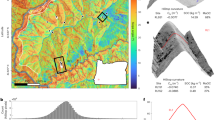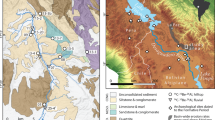Abstract
The extent and persistence of the Earth’s soil cover depends on the long-term balance between soil production and erosion. Higher soil production rates under thinner soils provide a critical stabilizing feedback mechanism1,2,3, and climate- and lithology-controlled soil production is thought to set the upper limit for steady-state hillslope erosion4. In this framework, erosion rates exceeding the maximum soil production rate can be due only to bedrock mass wasting5. However, observation of pervasive, if patchy, soil cover in areas of rugged topography and rapid erosion indicates additional stabilizing mechanisms. Here we present 10Be-derived estimates of soil-production and detrital erosion rates that show that soil production rates increase with increasing catchment-averaged erosion rates, a feedback that enhances soil-cover persistence. We show that a process transition to landslide-dominated erosion in steeper, more rapidly eroding catchments results in thinner, patchier soils and rockier topography, but find that there is no sudden transition to bedrock landscapes. Instead, using our global data compilation, we suggest that soil production may increase in frequency and magnitude to keep up with increasing erosion rates. We therefore conclude that existing models6,7,8 greatly exaggerate changes in critical-zone processes in response to tectonic uplift.
This is a preview of subscription content, access via your institution
Access options
Subscribe to this journal
Receive 12 print issues and online access
$259.00 per year
only $21.58 per issue
Buy this article
- Purchase on Springer Link
- Instant access to full article PDF
Prices may be subject to local taxes which are calculated during checkout




Similar content being viewed by others
References
Ahnert, F. Brief description of a comprehensive three-dimensional process-response model of landform development. Z. Geomorph. N. F. 25, 29–49 (1976).
Anderson, R. S. & Humphrey, N. F. in Quantitative Dynamic Stratigraphy (ed. Cross, T. A.) 349–361 (Prentice-Hall, 1989).
Carson, M. & Kirkby, M. Hillslope Form and Process (Cambridge Univ. Press, 1972).
Heimsath, A. M., Dietrich, W. E., Nishiizumi, K. & Finkel, R. C. The soil production function and landscape equilibrium. Nature 388, 358–361 (1997).
Larsen, I. J., Montgomery, D. R. & Korup, O. Landslide erosion controlled by hillslope material. Nature Geosci. 3, 247–251 (2010).
Tucker, G. E. & Hancock, G. R. Modelling landscape evolution. Earth Surf. Process. Landf. 35, 28–50 (2010).
Pelletier, J. D. & Rasmussen, C. Quantifying the climatic and tectonic controls on hillslope steepness and erosion rate. Lithosphere 1, 73–80 (2009).
Dietrich, W. E. et al. in Prediction in Geomorphology Vol. 135 (eds Wilcock, Peter R. & Iverson, R.) 103–132 (Geophysical Monograph Series, AGU, 2003).
Brantley, S. L. et al. Frontiers in Exploration of the Critical Zone: Report of a workshop sponsored by the National Science Foundation (NSF). October 24-26, 2005, Newark, Delaware (2006).
DiBiase, R. A., Whipple, K. X., Heimsath, A. M. & Ouimet, W. B. Landscape form and millennial erosion rates in the San Gabriel Mountains, CA. Earth Planet. Sci. Lett. 289, 134–144 (2010).
Yanites, B. J., Tucker, G. E. & Anderson, R. S. Numerical and analytical models of cosmogenic radionuclide dynamics in landslide-dominated drainage basins. J. Geophys. Res. 114, F01007 (2009).
Spotila, J. A., House, M. A., Blythe, A. E., Niemi, N. A. & Bank, G. C. Controls on the erosion and geomorphic evolution of the San Bernardino and San Gabriel Mountains, southern California. Geol. Soc. Am. Spec. Pap. 365, 205–230 (2002).
Peterson, M. D. & Wesnousky, S. G. Fault slip rates and earthquake histories for active faults in Southern California. Bull. Seismol. Soc. Am. 84, 1608–1649 (1994).
Ouimet, W. B., Whipple, K. X. & Granger, D. E. Beyond threshold hillslopes: Channel adjustment to baselevel fall in tectonically active mountain ranges. Geology 37, 579–582 (2009).
Binnie, S. A., Phillips, W. M., Summerfield, M. A. & Fifield, L. K. Tectonic uplift, threshold hillslopes, and denudation rates in a developing mountain range. Geology 35, 743–746 (2007).
Norton, K., von Blanckenburg, F. & Kubik, P. Cosmogenic nuclide-derived rates of diffusive and episodic erosion in the glacially sculpted upper Rhone Valley, Swiss Alps. Earth Surf. Process. Landf. 35, 651–662 (2010).
Schmidt, K. M. & Montgomery, D. R. Limits to relief. Science 270, 617–620 (1995).
Strahler, A. N. Equilibrium theory of erosional slopes approached by frequency distribution analysis. Am. J. Sci. 248, 673–696; 800–814 (1950).
Burbank, D. W. et al. Bedrock incision, rock uplift and threshold hillslopes in the Northwestern Himalayas. Nature 379, 505–510 (1996).
Heimsath, A. M. Eroding the land: Steady-state and stochastic rates and processes through a cosmogenic lens. Geol. Soc. Am. Spec. Pap. 415, 111–129 (2006).
Roering, J. J., Kirchner, J. W. & Dietrich, W. E. Hillslope evolution by nonlinear, slope-dependent transport: Steady state morphology and equilibrium adjustment timescales. J. Geophys. Res. 106, 16499–16513 (2001).
DiBiase, R. A., Heimsath, A. M. & Whipple, K. X. Hillslope response to tectonic forcing in threshold landscapes. http://dx.doi.org/10.1002/esp.3205 (2012).
Niemi, N. A., Oskin, M., Burbank, D. W., Heimsath, A. J. M. & Gabet, E. J. Effects of bedrock landslides on cosmogenically determined erosion rates. Earth Planet. Sci. Lett. 237, 480–498 (2005).
Lavé, J. & Burbank, D. W. Denudation processes and rates in the Transverse Ranges, southern California: Erosional response of a transitional landscape to external and anthropogenic forcing. J. Geophys. Res. 109, F01006 (2004).
Heimsath, A. M., Chappell, J. & Fifield, K. Eroding Australia: Rates and processes from Bega Valley to Arnhem Land. Geol. Soc. Lond. Spec. Publ. 346, 225–241 (2010).
von Blanckenburg, F. The control mechanisms of erosion and weathering at basin scale from cosmogenic nuclides in river sediment. Earth Planet. Sci. Lett. 242, 223–239 (2006).
Dixon, J. L., Heimsath, A. & Amundson, R. The critical role of saprolite weathering and climate in landscape evolution. Earth Surf. Process. Landf. 34, 1507–1521 (2009).
Balco, G., Stone, J. O., Lifton, N. A. & Dunai, T. J. A complete and easily accessible means of calculating surface exposure ages or erosion rates from 10Be and 26Al measurements. Quat. Geochronol. 3, 174–195 (2008).
Gosse, J. C. & Phillips, F. M. Terrestrial in situ cosmogenic nuclides: theory and application. Quat. Sci. Rev. 20, 1475–1560 (2001).
Bierman, P. R. Rock to sediment—Slope to sea with Be-10—Rates of landscape change. Annu. Rev. Earth Planet. Sci. 32, 215–255 (2004).
Acknowledgements
W.E. Dietrich helped A.M.H. collect the first SGM samples and sowed the concept of ‘bionic gophers’. Numerous graduate students assisted in sample collection and stimulating discussions on this work. NSF Geomorphology and Land Use Dynamics financially supported it. Laser altimetry was acquired and processed by NCALM with support from ASU and Caltech. A thoughtful review by G. Tucker improved the manuscript.
Author information
Authors and Affiliations
Contributions
All authors conducted field work, contributed to the experimental design and writing of this manuscript. A.M.H. carried out CRN chemical analyses; A.M.H. and R.A.D. analysed the CRN data.
Corresponding authors
Ethics declarations
Competing interests
The authors declare no competing financial interests.
Supplementary information
Supplementary Information
Supplementary Information (PDF 1146 kb)
Rights and permissions
About this article
Cite this article
Heimsath, A., DiBiase, R. & Whipple, K. Soil production limits and the transition to bedrock-dominated landscapes. Nature Geosci 5, 210–214 (2012). https://doi.org/10.1038/ngeo1380
Received:
Accepted:
Published:
Issue Date:
DOI: https://doi.org/10.1038/ngeo1380
This article is cited by
-
Quantifying erosion rates and weathering pathways that maximize soil organic carbon storage
Biogeochemistry (2023)
-
Deciphering non-steady landscape evolution by in-situ cosmogenic nuclide depth profile
Science China Earth Sciences (2022)
-
Ecosystem-bedrock interaction changes nutrient compartmentalization during early oxidative weathering
Scientific Reports (2019)
-
Predicting soil thickness on soil mantled hillslopes
Nature Communications (2018)
-
The influence of climate and topography on chemical weathering of granitic regoliths in the monsoon region of China
Acta Geochimica (2018)



